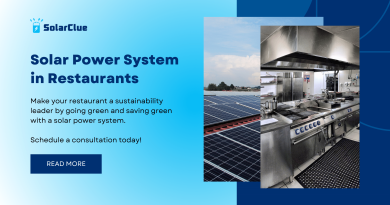What is a Rooftop On-Grid Solar Power System?
Rooftop solar power systems are becoming increasingly popular as a sustainable and cost-effective solution for generating electricity. Specifically, on-grid solar power systems are gaining traction due to their ability to directly connect to the power grid, providing homeowners and businesses with significant benefits. In this blog, we will delve into the concept of a rooftop on-grid solar power system, discussing its components, advantages, installation process, and potential challenges.
Table of Contents
Understanding Rooftop On-Grid Solar Power Systems
Rooftop on-grid solar power systems, also known as grid-tied solar systems, allow users to generate electricity using solar panels installed on their roof. The primary distinction between an on-grid system and an off-grid system is that the former remains connected to the local power grid, enabling users to both consume power from the grid and sell excess energy back to it. These systems consist of various components, including solar panels, inverters, meters, and a connection to the grid.
The Components of a Rooftop On-Grid Solar Power System
1. Solar Panels: The core of an on-grid solar power system lies in its solar panels. These panels are composed of several interconnected photovoltaic (PV) cells, seamlessly converting sunlight into direct current (DC) electricity.
2. Inverters: Transitioning from direct current (DC) to alternating current (AC), electricity generated by the solar panels undergoes conversion using inverters. This crucial conversion process ensures compatibility with both electrical appliances and the grid.
3. Meters and Monitoring Systems: On-grid systems seamlessly incorporate meters to measure both the electricity consumed from the grid and the excess electricity fed back into it. Furthermore, monitoring systems empower users to track and analyze the performance of their solar power system.
4. Connection to the Grid: Transitioning seamlessly from installation, a licensed electrician actively connects the on-grid solar power system to the local power grid. This vital connection guarantees the smooth transfer of electricity between the solar system and the grid.
The Benefits of Rooftop On-Grid Solar Power Systems
1. Financial Savings: By generating electricity through solar panels, users can significantly reduce their monthly electricity bills. In some cases, if excess energy is generated and fed back to the grid, users may even receive credit or compensation from the utility company.
2. Environmental Sustainability: Rooftop on-grid solar power systems, powered by clean and renewable energy from the sun, significantly reduce dependence on fossil fuels. Consequently, this results in a substantial decrease in carbon emissions, effectively contributing to the ongoing battle against climate change.
3. Net Metering: One of the key advantages of on-grid systems is net metering. When a solar power system generates more electricity than it consumes, it feeds the excess energy back into the grid, effectively running the meter backward. Later, users can utilize this surplus electricity when energy production from the solar panels is insufficient, such as during nighttime or cloudy days.
4. Minimal Maintenance: On-grid solar power systems require minimal maintenance. Routine cleaning of solar panels and occasional inspections of the entire system are generally sufficient to ensure optimal performance.
Installation Process of Rooftop On-Grid Solar Power Systems
1. Site Assessment: Prior to installation, a thorough site assessment is necessary to evaluate the suitability of the location for the solar power system. Factors such as roof orientation, shading, and structural integrity are considered during this phase.
2. Design and Engineering: Following the site assessment, a custom solar power system design is created. This design meticulously includes the number of solar panels, inverter capacity, and the electrical layout necessary to maximize the system’s performance.
3. Permitting and Approvals: Obtaining the necessary permits and approvals from local authorities is essential before installing a rooftop on-grid solar power system. This step ensures compliance with all relevant regulations and standards.
4. Installation: Experienced solar installers carry out the installation process, which involves mounting the solar panels on the roof, connecting the electrical components, and integrating the system with the grid.
5. Grid Connection and Commissioning: A licensed electrician connects the system to the grid, ensuring proper electrical wiring and compliance with safety protocols. Once the system is connected, it is commissioned to start generating electricity.
Challenges and Considerations
While rooftop on-grid solar power systems offer numerous benefits, some challenges and considerations need to be taken into account:
1. Initial Investment: The installation cost of a rooftop on-grid solar power system may be relatively high. However, various financial incentives, such as tax credits and rebates, can significantly reduce the upfront expenses.
2. Grid Dependence: On-grid systems are reliant on the grid for energy when solar production is insufficient. This means that during grid outages, the system will not provide power unless additional battery storage is installed.
3. Grid Connection Policies: Utility companies in some regions may have grid connection policies, such as feed-in tariffs or interconnection agreements, that regulate how they compensate or purchase excess energy. Understanding and complying with these policies is crucial for maximizing the benefits of a rooftop on-grid solar power system.
Conclusion
Let SolarClue® illuminate your path to a sustainable future with rooftop on-grid solar power systems, revolutionizing the way we generate electricity. These systems, seamlessly connecting to the grid, offer financial savings, environmental sustainability, and the convenience of net metering. To embark on this solar journey successfully, understanding the components, benefits, installation process, and potential challenges of on-grid systems is crucial.
SolarClue® stands as your trusted ally, guiding you through every step of the way. Embracing this renewable energy source not only empowers individuals and businesses but also allows you to contribute to a cleaner and greener future while reaping the advantages of solar power. Join the solar revolution now with SolarClue® leading the charge towards a brighter and more sustainable energy landscape. Take action today and harness the power of the sun with SolarClue® as your partner in solar solutions.
Frequently Asked Questions
A rooftop on-grid solar power system is a setup where solar panels are installed on the roof of a building, generating electricity that is connected to the local power grid.
The system converts sunlight into electricity through solar panels. This power is then used in the home, and any excess can be sent back to the grid, often earning credits.
Benefits include reduced electricity bills, environmental sustainability, and the potential to earn credits by selling surplus energy back to the grid.
While they generate less power during cloudy days, rooftop on-grid solar systems can still produce electricity, and users can rely on the grid during periods of low solar output.
Generally, rooftop on-grid systems do not store excess energy. Instead, surplus power is fed back into the grid, and users can draw power from the grid when needed.
Many regions offer incentives, such as tax credits or rebates, to encourage the adoption of rooftop solar systems, making them more financially attractive.
On average, these systems have a lifespan of 25 to 30 years. Regular maintenance can help ensure optimal performance throughout their lifespan.
The capacity of the system determines its ability to power a home. Larger systems can cover most or all of a household’s electricity needs.
While different types of roofs can support solar panels, optimal results are achieved on roofs with good sun exposure and structural integrity.
Installation times vary based on factors like system size and complexity, but on average, a residential installation may take a few days to a couple of weeks.


